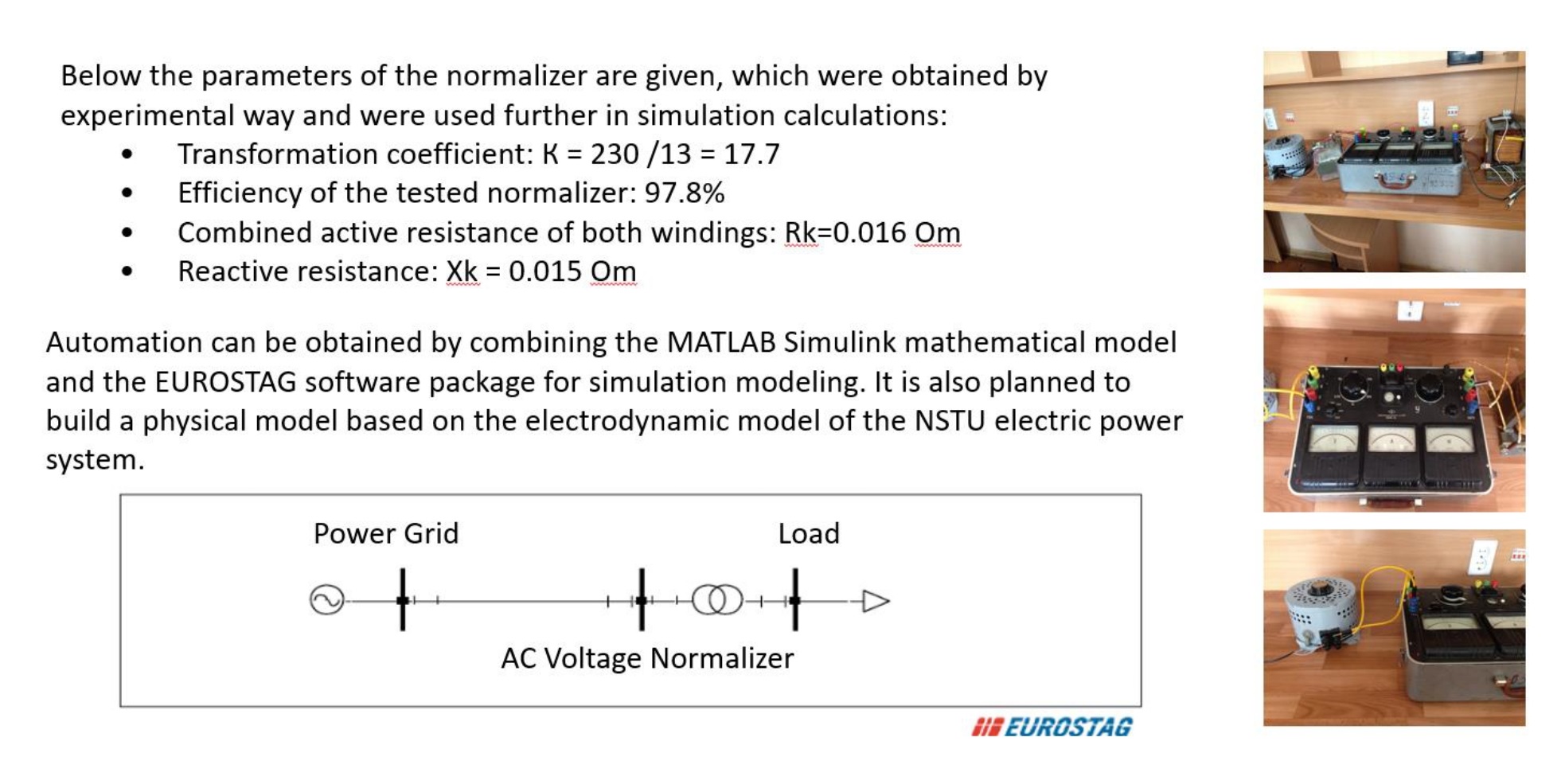ABOUT NORMEL
Solution: NORMEL.
Introducing NORMEL – a revolutionary energy-saving solution that enhances the performance and lifespan of your equipment while reducing electricity consumption.
How does NORMEL work?
• The device utilizes autotransformers, transmitting power through electric coupling and electromagnetic means.
• NORMEL maintains output within a predetermined range, irrespective of variations in the AC power source, ensuring no power interruptions or distortion of the AC sine wave. External frequency distortions are effectively filtered.
Key Features and Facts for Normel Technology
• Pricing comparable to 2-3 months of electricity consumption for the protected equipment.
• Average payback period of 1-3 years, considering only the savings on electricity expenses.
• Over 6,000 installations worldwide (approximately 1,000 in Europe).
• Plug and play – the installation is easy and does not require modifications to the current setup.
• Multiple patents and recognitions:
- 2003 – Patent for invention No. 2237270
- 2006 - US Patent No. 7,816,894 "Method and Apparatus for Regulating Voltage"
- 2008 - Patent No. 2377630
- 2011 - Patent No. 120499 "Device for Regulating Voltage of Consumer Electrical Installations"
- 2013 - Eurasian Patent No. 018813
- 2013 - Patent No. 103498
- 2016 - EU Patent No. 2343620 "Alternating Voltage Stabilizer with Protection Elements (Embodi-ments)"
- 2016 - Patent No. 2618115 "Normalizer of Alternating Voltage"
- 2021 - Application No. 2021119294 "System and Method for Resource Consumption Management" (for an upcoming series of devices)
Market demand for Normel technology
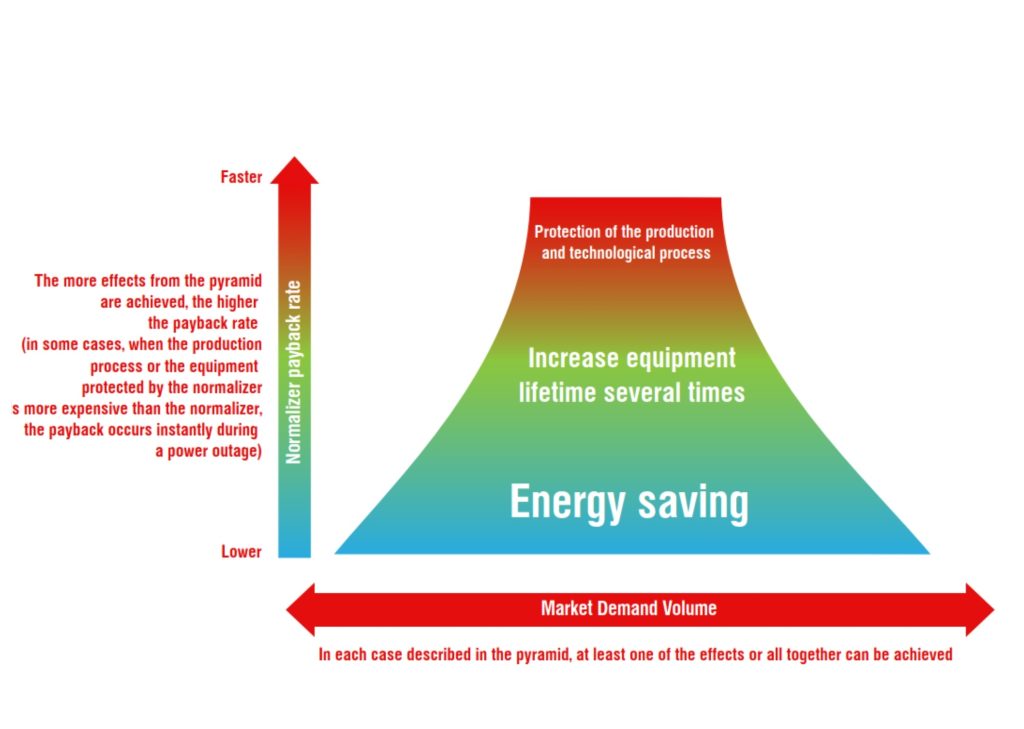
Each electrical device has critical indicators that influence its operation. The primary electricity parameters that substantially affect electrical equipment include:
Voltage:
Voltage variations, including high and low voltages as well as surges and dips, can have a significant impact on equipment performance and longevity.
High voltage
Persistent high voltage levels in the electrical network can lead to accelerated wear and tear or even failure of equipment. Often, the voltage in the network deviates from the standard 230 volts, with higher values being more common. This deviation results in increased electricity costs and reduced equipment lifespan due to the elevated risk of failure. Some processes (manufacturing, chemical etc.) will also be affected resulting in production quality drop.
Low voltage
Low voltage levels can negatively affect the performance of most equipment. Production machinery may operate abnormally, potentially resulting in substandard output or even equipment failure, disrupting the production process. A voltage below 210 volts is considered critically low for many electrical devices, and most process equipment manufacturers do not guarantee proper operation under these conditions. For instance, in cooling system compressors (such as refrigeration equipment and air conditioners), failure of protective mechanisms during low voltage conditions may lead to the breakdown of the entire compressor system..
Higher Harmonics, carrier Frequency Fluctuations (50 Hz)
Frequency refers to the number of cycles per second (measured in Hertz) of the alternating current (AC) waveform. In most countries, the standard frequency is either 50 Hz or 60 Hz. Variations in frequency can lead to equipment instability or malfunction, as many devices are designed to operate optimally at the specified frequency. Frequency fluctuations can be caused by factors such as load changes, generator speed variations, or power grid disturbances
Harmonics are distortions in the AC waveform that occur due to the presence of non-linear loads, such as electronic devices, variable frequency drives, or transformers. These distortions result in additional frequencies that are integer multiples of the fundamental frequency (e.g., 2nd, 3rd, 4th harmonics, and so on). Harmonics can cause various issues, such as overheating, equipment malfunction, and reduced efficiency, as well as interference with communication systems. They can also lead to increased power consumption and higher utility costs.
These parameters are particularly critical for computing and digital technology, as the operational frequency of computer processor centers often depends on the network frequency provided by the electricity supplier. Changes in frequency purity can impact the overall computing process in devices ranging from simple electronic clocks connected to the network to data processing centers (DPCs). Manufacturers strive to protect these delicate processes from poor-quality power supply; however, achieving complete protection through built-in systems in these devices is not always feasible.
Voltage unbalance
Unequal voltages in a three-phase system can cause motor overheating, reduced efficiency, and premature equipment failure.
Power factor
The ratio of real power to apparent power, which indicates the efficiency of power usage. A low power factor can result in increased power consumption and higher utility costs.
Extra effects:
- Reduced energy consumption in the grid creates additional capacity, which can be utilized to install extra equipment and increase production, extend operations, or initiate new projects within the existing facility.
- The Normalizer contributes to investments, and as operating costs decrease, the economic efficiency and overall value of the business increase. This, in turn, allows for more investment in core activities.
Working principles
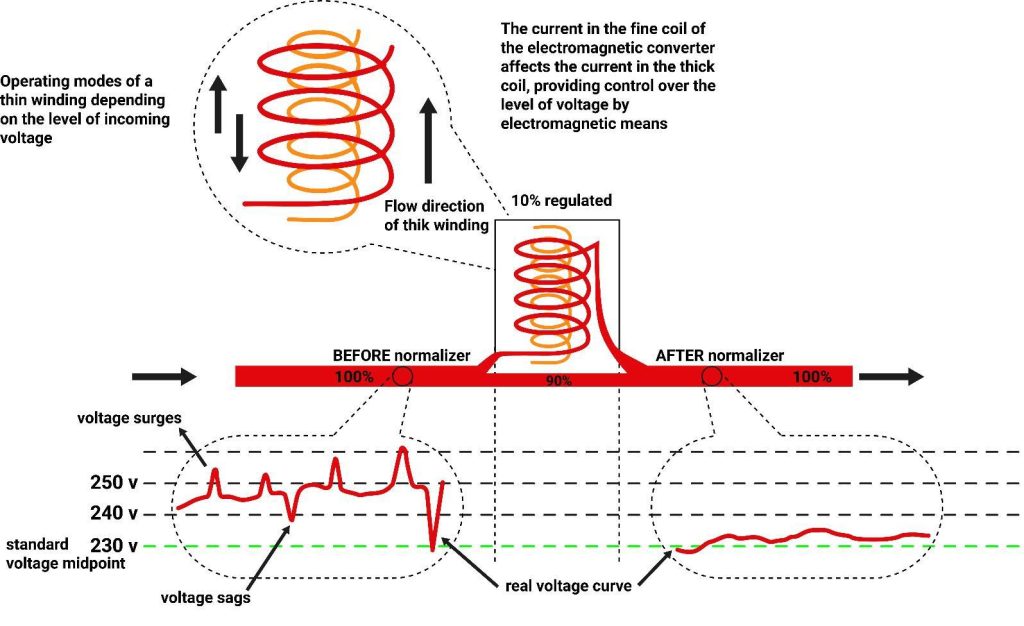
The primary distinction between the known autotransformational regulation of electric power flow and the proposed method lies in the integration of phase retardation coils and the resulting regulation of output network parameters. This method offers several advantages in terms of technical, operational, size, cost, and reliability aspects, including:
- Continuous regulation without disrupting the power network, eliminating issues associated with commutations and the transient phenomena they cause.
- Since 95% of the normalizer’s power is transferred electrically and only 5% electromagnetically, the retardation coils used in the device have a power rating corresponding to 5% of the normalizer’s nominal power. This impacts the size, weight, and overall cost of the device.
- The absence of power commutation elements in the circuit allows for a long, faultless operational lifespan of at least 15 years.
The main difference utilized in the NORMEL circuit is that the regulation of network parameters occurs not through phase power contour commutations, but by introducing electromotive forces with different directions within them. This is achieved by altering the polarity of the thin winding of phase retardation coils in relation to their thick (power) winding.
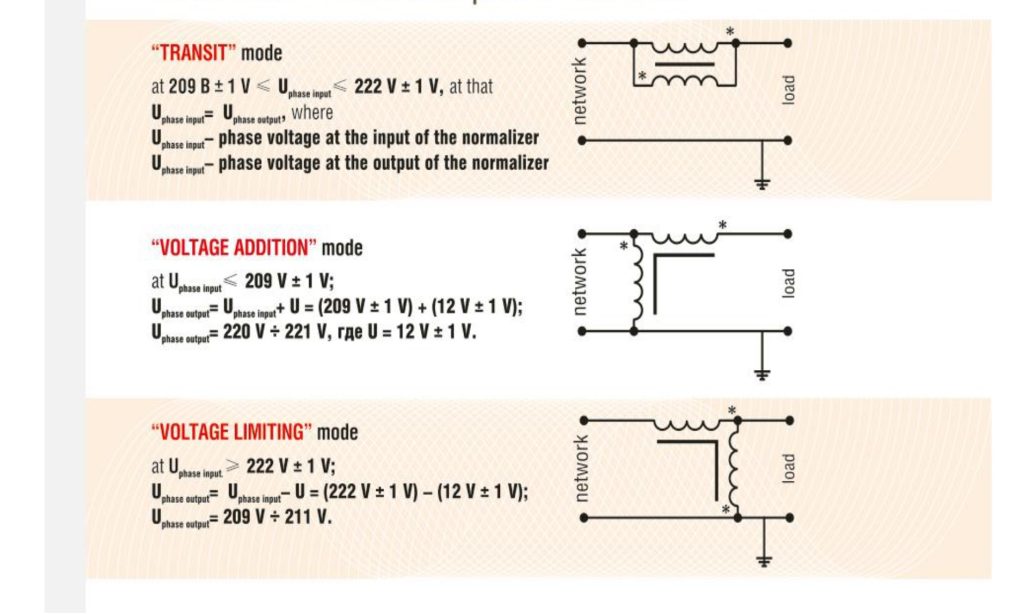
Comparison of Normel Technology with other energy saving and alternative energy solutions
Photovoltaic systems
Consider an example of a solar system with a cost of EUR 6,000. Prior to the installation of solar panels, the property owner’s annual electricity bills totaled EUR 1,200. In this example, the solar panels come with a 15-year warranty, while the Hoymiles microinverters used in the solar system have a 25-year warranty. Therefore, the overall warranty period for the solar system is 15 years.
Assuming that in this scenario, the solar installation can provide all the electricity the homeowner needs, the owner would save on electricity bills for 15 years. In reality, a solar installation might not generate 100% of the required electricity, and the amount of electricity produced by a solar system will naturally decline over time due to panel degradation. However, for simplicity, we will use the 15-year figure to explain the calculations.
Thus, the solar system saves the property owners a total of EUR 18,000. To calculate the net benefit, subtract the total cost from the total benefit: 18,000 – 6,000 = 12,000. To calculate the ROI, divide the net benefit by the total cost and divide it by the number of years (assuming that inflation will be offset by the increase in energy costs): 12,000 / 6,000 / 15 = 13.3%, which is an impressive figure.
Alternatively, ROI can be calculated by dividing the total savings (EUR 1,200 minus equipment depreciation) by the total investment: (1,200 – (6,000 / 15)) / 6,000 = 13.3%, which confirms the same result.
In a previous example, we calculated the efficiency of a Normalizer to be over 30%. Therefore, it would be advisable to estimate the efficiency of a Normalizer before considering other energy efficiency measures.
Smart grid – a key component.
How does the Normel technology support smart grid and how it works with other energy management technologies?
A smart grid is an electricity network that uses digital technology to monitor and manage the transport of electricity from all generation sources to meet the varying electricity demands of end-users. Smart grids co-ordinate the needs and capabilities of all generators, grid operators, end-users, and electricity market stakeholders to operate all parts of the system as efficiently as possible, minimizing costs and environmental impacts while maximizing system reliability, resilience, and stability.
Smart grid utilizes features like two-way communication, unified automation and control, integration of Renewable Energy Sources, improved grid reliability and resilience, demand response, data driven operation and some others.
The Normel Normalizer, an energy optimization device, can significantly enhance the operations of a smart grid – an electricity network that uses digital technology for efficient power management. Here’s how:
- Power Quality Improvement: By stabilizing voltage and reducing harmonics, the Normalizer ensures the steady, high-quality power supply essential for smart grid operations.
- Energy Efficiency: The Normalizer’s capacity to lower energy consumption aligns with the smart grid’s goal of optimizing energy use, benefiting end-users by reducing their energy costs.
- Grid Stability Enhancement: The Normalizer aids in maintaining overall grid stability, critical in a smart grid environment with complex two-way power flows, by normalizing supply voltage.
- Peak Demand Reduction: The Normalizer indirectly aids in reducing peak demand, a crucial smart grid function, by optimizing the performance of electrical equipment, hence lowering overall power consumption.
- Support for Renewable Integration: The Normalizer’s voltage stabilization capabilities prove beneficial when renewable energy sources, which often introduce voltage variability, are connected to the grid.
- Data for Analytics: If equipped with monitoring features, the Normalizer can provide valuable data on power quality and energy consumption patterns for the smart grid’s advanced analytics, assisting in optimization and decision-making.
- Transmission Loss Reduction: Reducing the voltage by 12V using the Normalizer can cut network losses by at least 10%.
- Increased Capacities: The Normalizer can add up to 10% additional grid capacity, beneficial for existing/new connections and during repair, reconstruction, and modernization works.
- Control Component: The device facilitates electricity consumption control at the 0.4 kV level from the central grid control center.
- Standard Compliance: The Normalizer helps maintain the set voltage level within proper thresholds, supporting the implementation of electricity quality standards.
In essence, the Normel Normalizer’s functionalities not only align with but can also enhance the objectives of a smart grid, making it a valuable addition to the smart grid ecosystem.
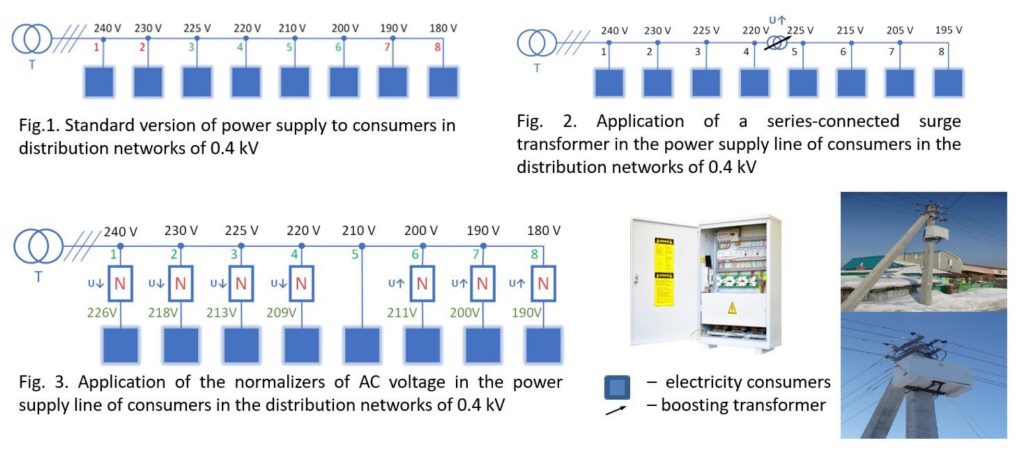
How does various equipment work under various voltages

